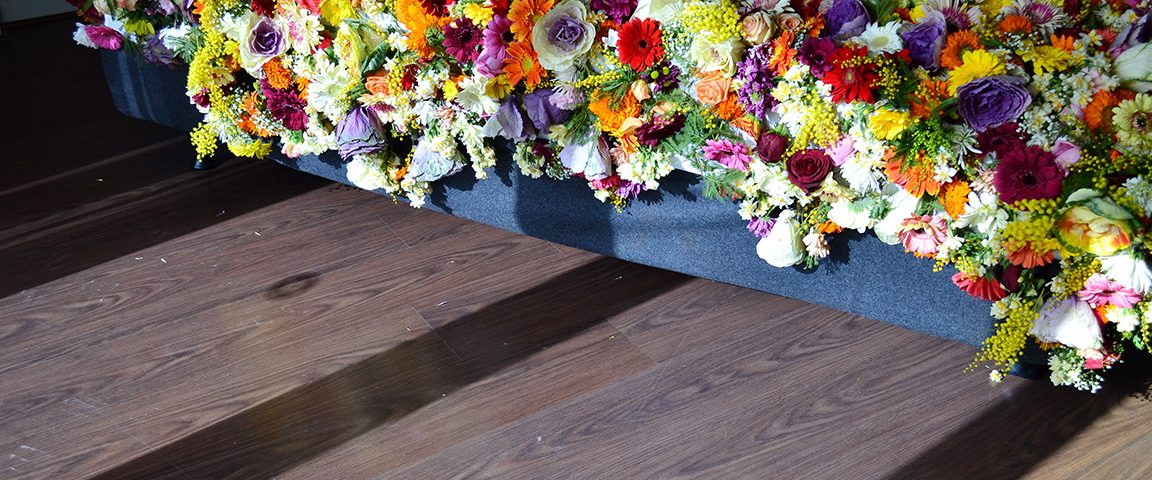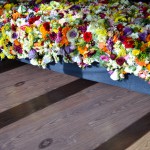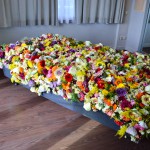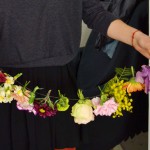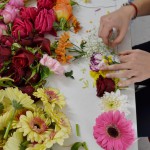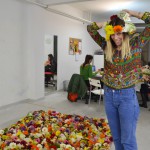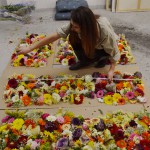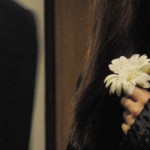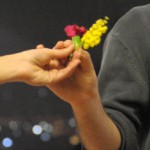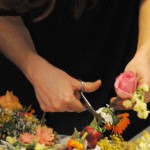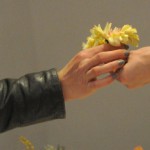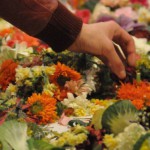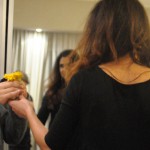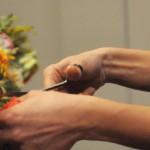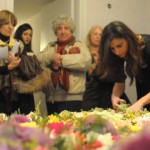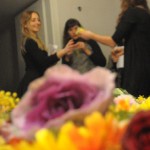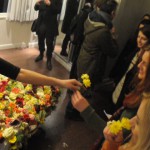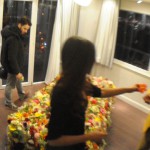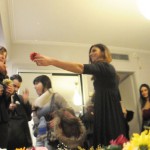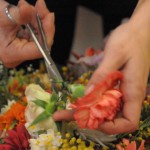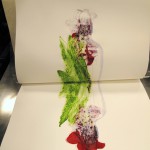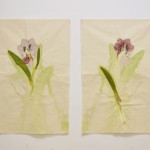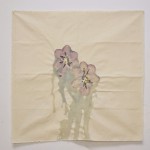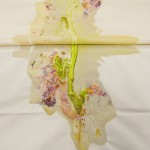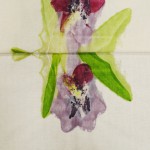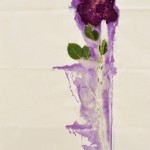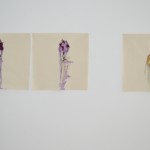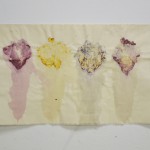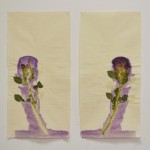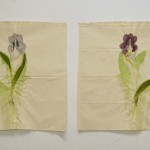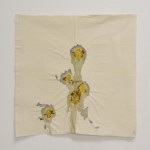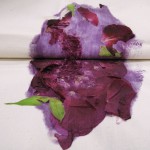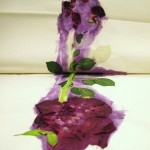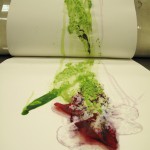Installation & Making of
Videostills
Flower Prints
I wish your wish 2013
Installation and performance. 1.400 real flowers, waxed thread, scissors. Dimensions variable.
I wish your wish is the outcome of a collective action, a temporary installation and a 4-hour performance that raises issues about collectivity, generosity, and the politics of services.
Ten women are invited by the artist in her studio in order to sew together 1.400 real flowers, creating a cover for a hotel’s bed. When the cover is ready, it is taken to room 504 of St. George Lycabettus Hotel, where it is laid down on the bed like a garden that is resting, and the space is transformed into an “olfactory bomb”. The artist, in a 4-hour performance with the use of scissors, begins to cut off each flower offering them open-handedly to each viewer.
The work is created by a collective offering and is concluded in the same fashion when all the flowers have been offered to the viewers and the bed cover has dissolved. The primary aim of its creation is to be given away, to be distributed to the viewers’ hands, and each flower can then take its own course. All viewers leave the room with a flower that has been offered to them; a portion of the work that it was given to each one; a portion that, as a result of a dismantled body, was entrusted to each one by the artist.
Rooms 2013, St. George Lycabettus Hotel, curated by Charis Kanellopoulou, Gallery Kappatos, Athens.
I wish your wish 2013
Εγκατάσταση και performance. 1.400 αληθινά λουλούδια, κέρινη κλωστή. Διαστάσεις μεταβλητές.
Το έργο I wish your wish είναι το αποτέλεσμα μια συλλογικής δράσης, μιας εφήμερης εγκατάστασης και μιας performance 4 ωρών που θέτει ζητήματα γύρω από την συλλογικότητα, την γενναιοδωρία και την πολιτική των υπηρεσιών.
Δέκα γυναίκες καλούνται από την καλλιτέχνιδα στο εργαστήριό της, προκειμένου να ράψουν σε μια μέρα 1.400 αληθινά λουλούδια μεταξύ τους, δημιουργώντας ένα ενιαίο κάλυμμα για το κρεβάτι ενός ξενοδοχείου. Το ξημέρωμα της επόμενης μέρας, το κάλυμμα μεταφέρεται στο δωμάτιο 504 του St.George Lycabettus Hotel όπου αφήνεται στο κρεβάτι σαν ένας κήπος που αναπαύεται και ο χώρος μεταμορφώνεται σε μια «οσφρητική βόμβα». Την ίδια μέρα η καλλιτέχνιδα σε μια δράση διάρκειας 4 ωρών, κόβει μ’ ένα ψαλίδι αυτό το πλέγμα και προσφέρει γενναιόδωρα ένα λουλούδι σε κάθε θεατή.
Τα λουλούδια εδώ λειτουργούν ως φορείς ευχών, επιθυμιών, ως πρωταγωνιστές σε μια δράση μ’ έντονο τελετουργικό χαρακτήρα. Το έργο δημιουργείται μέσα σ’ ένα πνεύμα συνεργασίας και τελειώνει μ’ έναν χαρακτήρα προσφοράς όταν όλα τα λουλούδια έχουν προσφερθεί στον κόσμο και το κάλυμμα έχει εξαφανιστεί. Μοναδικός σκοπός της δημιουργίας του είναι να χαριστεί, να μοιραστεί σε νέα χέρια και το κάθε λουλούδι να ξεκινήσει μια σύντομη ιστορία ζωής. Κάθε θεατής αποχωρεί από το δωμάτιο μ’ ένα λουλούδι που του προσφέρθηκε, μ’ ένα μέρος του έργου που του χαρίστηκε, μ’ ένα κομμάτι που σαν σώμα η καλλιτέχνιδα του εμπιστεύεται.
Rooms 2013, Ξενοδοχείο St. George Lycabettus, Επιμέλεια: Χάρις Κανελλοπούλου, Αθήνα, Ελλάδα.
Τα λουλούδια που μάζεψε
άνθισαν τη σύντομη λαμπερή ώρα τους,
ύστερα έραναν τα πέταλά τους σε μια σιωπηλή βροχή.
Richard Rowe (1828-1879)
Το λουλούδι, σύμβολο του εφήμερου και της ευθραυστότητας, που έχει όμως μέσα του την ανανεωτική δύναμη της αναγέννησης και της δημιουργίας, είναι το υλικό με το οποίο η Μαρία Τσάγκαρη δημιουργεί ένα εικαστικό περιβάλλον προσφοράς και εκμυστήρευσης επιθυμιών, ευχών κι ευχαριστιών. Κινούμενη στο εννοιολογικό πλαίσιο προηγούμενων εφήμερων εγκαταστάσεών της με πρώτη ύλη τη στάχτη, παρουσιάζει κι αυτή τη φορά ένα έργο που πραγματώνεται μέσα από μια διαδικασία έντονου χειρωνακτικού χαρακτήρα, βιώνοντας μια εμπειρία που βασίζεται στην αυτοσυγκέντρωση και την εσωτερική αναζήτηση, επενδύεται από επίμονη και συστηματική εργασία, απαιτεί τη διαρκή προσήλωση του σώματος και της ψυχής έως τη γέννηση της τελικής δημιουργίας.
Η σύντομη ζωή του εύθραυστου υλικού της εγκατάστασης της Τσάγκαρη ενισχύει ακριβώς τη σημασία που δίνει η ίδια στη βιωματική εκφραστικότητα της διαδικασίας, παράγοντας ένα έργο «ζωντανό» για όσο μπορεί να διαρκέσει, και ανοικτό να δεχθεί την αναπόφευκτη κατάληξη μαρασμού του. Στο χρόνο της «δεδομένης» ζωής τους, τα κομμένα λουλούδια χαρίζουν στο δωμάτιο την ένταση του χρώματος και του αρώματός τους, ενώ με την παρουσία τους λειτουργούν ως φορείς κωδικοποιημένων μηνυμάτων εκφράζοντας όσα δεν μπορούν με λόγια να ειπωθούν. «Υφαίνοντας» το άνθινο πλέγμα του έργου της μέσω ενός ιδιότυπου τελετουργικού προσφοράς, η Τσάγκαρη αφήνει να διεισδύσουν σε αυτό τα μεταφορικά νοήματα των λουλουδιών, χαρίσματα, αρετές και αδυναμίες που οι ίδιοι οι άνθρωποι τους έχουν χαρίσει. Το λουλουδένιο πέπλο που προκύπτει συγκεντρώνει αφιερώματα, ευχές και προσφορές, παραπέμποντας ως περιβάλλον στη σφαίρα της πίστης, στην έκφραση της ευγνωμοσύνης και στην εκδήλωση της λατρείας.
At a later time, as the artist dismantles the composition and the remaining flowers are left to wilt away, the realisation of the work’s transient, ephemeral nature focuses the viewer’s attention even more on the direct, experiential contact with things as they perceive it through the senses rather than know it. While the work is gradually ‘disembodied’, smell assumes the dominant role and provides a different, pure and primordial sense of things, abolishing all distinctions between viewer and object, self and other, internal and external.
Σε δεύτερο χρόνο, καθώς η σύνθεση διαλύεται από την καλλιτέχνιδα και τα εναπομείναντα λουλούδια αφήνονται να μαραθούν, η συνειδητοποίηση της παροδικότητας του εφήμερου στρέφει την προσοχή του θεατή ακόμα περισσότερο προς τη βιωματική, άμεση επαφή με τα πράγματα έτσι όπως τα αντιλαμβάνεται με τις αισθήσεις παρά όπως τα γνωρίζει. Ενόσω το έργο σταδιακά «εξαϋλώνεται», η οσμή λαμβάνει κυρίαρχο ρόλο, παρέχοντας μία διαφορετική, πρωταρχική και αγνή αίσθηση των πραγμάτων, καταρρίπτοντας κάθε διαχωρισμό μεταξύ θεατή και αντικειμένου, εαυτού και άλλου, εσωτερικού και εξωτερικού. Σε ένα εικαστικό περιβάλλον που έχει ήδη χαρτογραφηθεί μέσω της μνήμης, της σκέψης και της ευεργετικής εκφοράς του συναισθήματος, η απελευθέρωση της οσμής μοιάζει να οδηγεί σε μια διαφορετική μορφή «συναισθησίας», με τη μυρωδιά να είναι ικανή να ανακαλέσει εκ νέου κοινές αναμνήσεις και συγκινήσεις στο συνειδητό και το ασυνείδητο, αυτή τη φορά ως μία ακόμα πιο δυνατή μεταφορά. Είναι η εφήμερη ζωή του έργου και το ελάχιστο αποτύπωμα που απομένει –από την ολοζώντανη «σάρκα» του λουλουδιού που προσφέρεται μέχρι το λεπτό άρωμα που θυμίζει την κίνηση της προσφοράς του– που μας καλούν να εκτιμήσουμε τη στιγμή και να είμαστε καθ’ όλα παρόντες στην εμπειρία του έργου, με οξυμένες τις αισθήσεις και το συναίσθημα, ενδίδοντας στο πέρασμα του χρόνου και τιμώντας τον τρόπο με τον οποίο το απτό βίωμα μετατρέπεται σε μνήμη.
Χάρις Κανελλοπούλου
The flowers he gathered bloomed their brief bright hour, Then rained their petals in a silent shower Richard Rowe (1828-1879)
The flower as a symbol of fragility and the ephemeral, but also one which contains the potential for rebirth and creation, is the material with which Maria Tsagari creates a visual environment which fulfils and discloses desires, wishes and gratitude. Continuing in the conceptual concept of her earlier ephemeral installations made of ash, she presents again a body of work realised through an intensely manual process. In this way she gets an experience based on concentration and inner quest, invested with perseverance and systematic work and demanding the unwavering concentration of body and soul until the final outcome has emerged. The brief life of the fragile material in Tsagari’s installation underscores the importance she ascribes to the experiential expressiveness of the process; the work ‘lives’ for as long as it can go on, and is open to accepting its inevitable withering. During their finite life, the cut flowers fill the room with their colour and scent, at the same time conveying coded messages and expressing what cannot be said in words. As she ‘weaves’ the flowery fabric of her work in a peculiar ritual of offering, Tsagari allows it to be imbibed by the metaphorical notions—virtues and weaknesses—which people themselves have ascribed to them. The resulting veil of flowers carries vows, wishes and offerings, and the whole environment alludes to the sphere of faith, the expression of gratitude and the manifestation of worship. At a later time, as the artist dismantles the composition and the remaining flowers are left to wilt away, the realisation of the work’s transient, ephemeral nature focuses the viewer’s attention even more on the direct, experiential contact with things as they perceive it through the senses rather than know it. While the work is gradually ‘disembodied’, smell assumes the dominant role and provides a different, pure and primordial sense of things, abolishing all distinctions between viewer and object, self and other, internal and external. In a visual environment already mapped through memory, thought and the beneficial expression of emotion, the liberation of scent seems to lead to another form of ‘synaesthesia’, with smell being able to recall anew some common memories and emotional experiences in the conscious and the unconscious, this time as even more potent metaphor. It is the work’s transient life and the minimal trace it leaves behind—from the vibrant ‘flesh’ of the flower to the delicate scent which reminds us of the gesture of its offering—that call upon us to appreciate the moment and be fully present while experiencing the work, with heightened senses and emotions, surrendering to the passage of time and honouring the way in which tangible experience turns into memory.
Charis Kanelopoulou
Flower prints on fabric


